Rain, heat, and humidity generally aren’t the greatest growing conditions for roses. The hybrid teas that look stunning in a garden up north turn into leafless twigs in a Central Florida summer without regular fungicide use. Is it even worth trying to grow roses here? Yes, by choosing the right varieties, you can have beautiful, bountiful roses without spraying.
First, let’s talk about the barriers to growing roses here. The biggest is fungal disease. Most gardeners are familiar with blackspot on roses. This fungus thrives in wet conditions above 70 degrees, which describes our weather for most of the year. It can defoliate a rose completely, weakening it and even causing death. There are many varieties of roses that are blackspot resistant – the problem is that in Florida, we also have another foliar fungus called Cercospora leaf spot. It looks and acts a lot like blackspot, but roses that are resistant to one are often susceptible to the other. That’s why many of the landscape roses such as Knock Outs don’t do as well here as other places in the south – they are resistant to blackspot but fall to Cercospora leaf spot.
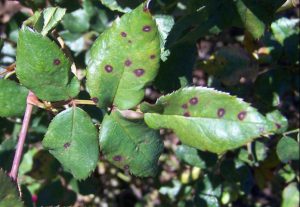
At the root level, Florida soils are home to microscopic nematodes. This is why most roses sold in Florida are grafted onto Fortuniana rootstock. This vigorous rootstock, originally from a huge white rambler rose, is resistant to nematodes. With very few exceptions, it’s best to buy grafted roses.
For many years, insect pests were not a major problem for Florida roses. Aphids and spider mites might attack, but generally don’t cause a plant to die. Around 2004, however, chilli thrips worked their way up from the south. Chilli thrips have a wide variety of host plants but especially love roses. They cause scarring and withering of new growth, and can weaken a plant enough to kill it. Chilli thrips are hard to fight with chemicals. But with good planning, there are other ways to circumvent this microscopic menace.
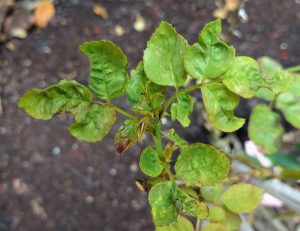
There are other pests and diseases of Florida roses, but those are the major players. So how do we defeat them and have beautiful, victorious roses? The most important step is choosing the right rose and the right spot. The easiest roses for Florida are generally heirlooms that grow into big bushes. They have leathery leaves that are resistant to fungal diseases and are so vigorous that new growth outpaces insect damage. They will be happiest in a sunny, well-drained spot with good airflow to dry leaves and prevent fungus. If possible, use drip irrigation to keep water off the leaves.
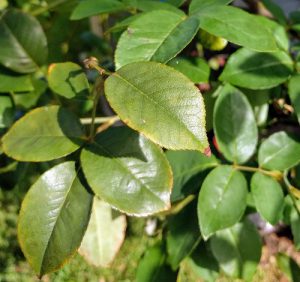
Second, plant good neighbors. The classic rose garden that contains nothing but rose bushes is an all-you-can-eat buffet for the bad bugs. They can go down the row, gorging unhindered. Instead, interplant with flowers that both enhance the beauty of the roses and invite beneficial insects for protection. One fantastic companion plant is Thai pepper – it hosts a beneficial mite that loves to eat chilli thrips – free pest control! Thai basil, zinnia, sweet alyssum, sunflowers, and herbs are also great choices. When inviting beneficials, be generous in planting. One little Thai pepper won’t host enough good guys to protect a dozen rose bushes. And remember, pesticides don’t know the difference between good bugs and bad ones, so don’t spray!
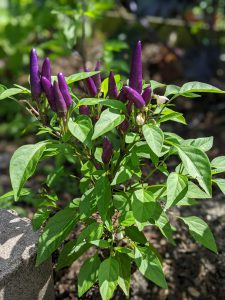
Finally, if you have the right rose in the right place, it won’t need much care to be beautiful. But a little extra effort can make it Instagram-worthy. Heirloom roses don’t like a hard pruning, but trimming it back in early February and September will keep it bushy. After the trim, fertilize with organic, slow-release fertilizer formulated for roses or blooming plants.
Here are a few standout roses for Central Florida that will thrive without spraying:
Mrs. B.R. Cant – This rose was named hands-down the best rose for Central Florida by an IFAS study. She’s big – at least 8 feet wide and tall – with huge pink blooms and a scent like Earl Grey tea. Her strong, upright canes make her a good vase rose. She is one of the few roses with high resistance to chilli thrips. In my garden, even though she was squished into a too-small spot and blown by air-conditioner exhaust, I never saw spots on her leaves. She will do well either own-root or grafted.
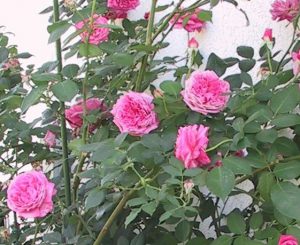
Tausendschon – If you’re looking for a rose that will stop traffic for a month in spring when it’s in full bloom, this is it. It will bloom sporadically the rest of the year, but is chilli thrips resistant and is nearly thornless. It is a huge rambler – I had it on a nine-foot arch and had to prune constantly. Try growing it up the second story of a house.
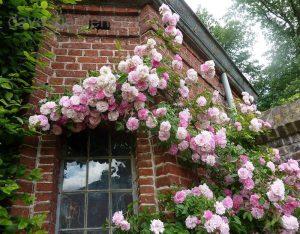
Louis Philippe – Also known as the “Florida Cracker Rose”, he can be found in many old homesites and cemeteries. Like Mrs. B. R. Cant, he grows to 8 feet wide but has twiggy stems and a lower profile. His crimson blooms are smaller but numerous. He can be propagated easily from cuttings and grown on his own roots.
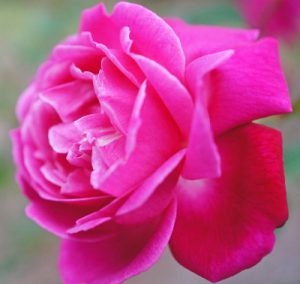
Duchesse de Brabant – A upright 4 foot wide by 5 foot high bush, she has nodding light pink blooms. Legend says Teddy Roosevelt always wore a bud as a boutonniere. Her leaves will spot, but the plant will survive.
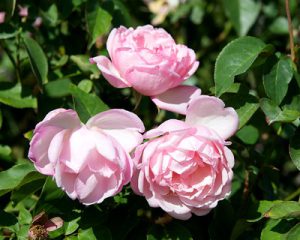
Bermuda Mystery Roses – This class of roses is made up of varieties that have survived for a hundred years or more in the heat and humidity of Bermuda. Often their original European names have been lost to time, but research is now linking them with their past identities. Spice and Smith’s White Parish are two Bermuda roses that performed well in Central Florida in an IFAS study. Spice is now believed to be Hume’s Blush Tea-Scented China, one of the four “stud” Chinas brought to Europe in the early 1800s and thought lost to history. I’ve grown two other Bermudas that stayed perfectly healthy without spraying – Maitland White, which has reddish thorns and foliage, and Miss Atwood, a peach-colored tea rose. These four varieties are all medium-sized 4×6 bushes.
Spice, or Hume’s Blush Tea-Scented China, was thought to be lost to history until it was rediscovered in Bermuda. It is a parent to many modern roses.
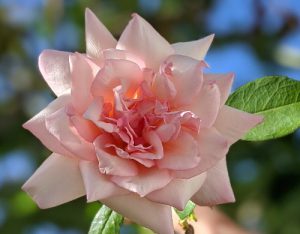
Roses don’t have to be difficult to grow. With the right variety, location, and neighbors, they can be a perfect Florida landscape plant.
This blog post was written by UF IFAS Extension Orange County Master Gardener, Mary Ann Pigora, class of 2017. The UF IFAS Extension Orange County Master Gardener Volunteers play a crucial role in the outreach of UF IFAS Extension.
Want to learn more? Check out horticulture classes offered by UF/IFAS Extension Orange County at www.ocextension.eventbrite.com. Read about Florida-Friendly Landscaping™ https://ffl.ifas.ufl.edu/. Follow us on Facebook https://www.facebook.com/GardenFlorida/, Instagram https://www.instagram.com/oc_extension/ and visit our website https://sfyl.ifas.ufl.edu/orange/home-lawns-landscapes-and-gardens/florida-friendly-landscaping/.
 1
1
